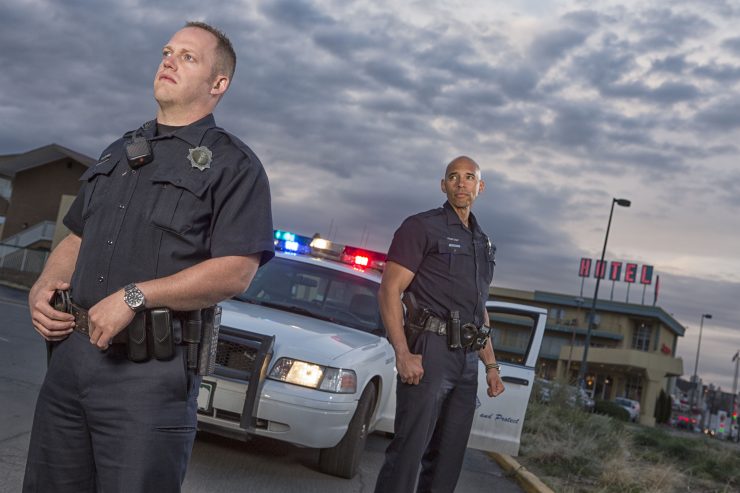Calibre Tip of the Week
A note from the editor: If you have a tip to share with officers around the country, please feel free to e-mail us at editor@calibrepress.com
 Don’t Be a “Target of Opportunity”
Don’t Be a “Target of Opportunity”
It’s important to use extra caution when patrolling territory contested by rival gang members. If personnel permit, you want at least three officers involved in gang contacts: one to serve as Contact Officer for dealing with the suspect(s); one to serve as the primary Cover Officer, watching the Contact Officer and the known suspect(s); and the third working as a secondary Cover Officer, watching the surrounding environment for threats.
The importance of this strategy was illustrated in an incident involving tac officers in the Midwest who stopped to question a known gang member. As they attempted to deal with this individual, two members of a rival gang, standing in a nearby alley, fired shots at the police car.
Officers fired back, hitting one suspect in the leg. A squad car responding to the scene was then fired on by other rival gang members.
Moral of the story: when it comes to gangs—or members of any threat group for that matter—you not only have to worry about the suspects you’re immediately concerned with, but also about their friends and their enemies, any of whom may seize upon your presence in the area as a “target of opportunity.”
 Be Sure to Cover Your Cover
Be Sure to Cover Your Cover
The best time to look for cover is not when you need it … it’s before you need it. Keep that in mind whenever you enter an area. Do a quick scene scan and identify what might be used as your closest cover source and keep it in mind. If you change locations, keep an eye out for new ones. These few seconds in pre-planning efforts could be priceless in a crisis.
 Emotion on the Stand
Emotion on the Stand
If you find yourself in court and needing to convince a jury that you used deadly force or took other serious measures against a suspect because you feared for your life, remember this is NOT the time to keep a stiff upper lip.
You’re not there to prove that you’re tough enough to handle life-threatening encounters and walk away unscathed. You’re there to prove that you are human and that you thought you were possibly going to die.
Showing true emotion can help prove your point. So resist the temptation to prevent yourself from choking up. Think about what it really felt like to be staring death in the face. Think about the impact on your family if you had died. Think about what it felt like to be that vulnerable…and let it out.
Remember, however, that if the only emotion you can summon when you think about those things is extreme anger, keep that in check. Blowing your top can do you serious damage on the stand
 Don’t Check the Time
Don’t Check the Time
Looking at your watch during an interrogation can be a big mistake, according to trainer Pat McCarthy, an expert on developing informants and surfacing information from even the most unlikely street sources. “Even just glancing at it during questioning gives the impression that you’ve got somewhere else to be and that you’re preparing to stop pressuring him because you need to move on to other business,” he says.
“This small move can inspire a reluctant or deceptive subject to stay dedicated to his fake story or keep his silence even longer. He figures that if he digs in, he can wait you out.”
Instead, McCarthy advises, you should give every impression that you’ve got all the time in the world.
“Relax. Take your time,” he says. “Your body language and verbal pacing should give the clear impression that you’ve got all the time in the world. Your subject needs to know that you’re in it for the long haul if that’s the way he wants to play it. If you’re not buying his story or he’s not talking, he needs to think that you’re a marathon runner, not a sprinter. You’ll stay in the race until you get what you need.”

Breaking the “Language Barrier”
If you need to communicate with a subject who claims that he can’t speak a lick of English, but you suspect he can, here’s a quick trick that can help you confirm or eliminate your suspicions.
Begin asking a fast-paced stream of the usual questions like, “What’s your name?” “Where do you live?” “Is this your car?” “Do you have a driver’s license?” Of course, the response you’ll get is “I don’t speak English” or “I don’t understand” spoken in his native language.
In the middle of your fruitless questioning, suddenly drop a comment, seemingly to yourself but clearly loud enough for him to hear it, like: “Man, I knew it! Guys like this always wear that kind of belt”…or always have those kinds of buttons on their shirt, or always wear those types of shoes.
Odds are pretty good that if the subject does, in fact, speak some English, he’ll reflexively look down to the area you refer to. With that, you’ve got your answer.

12 “Don’ts” for Drug Labs
If you encounter a drug lab or illicit drug-making materials, do not:
- Taste
- Touch
- Smell
- Pour
- Jiggle, swirl or mix
- Smoke
- Throw light switches
- Unplug or plugin
- Rub your eyes, nose or mouth
- Forget about guard dogs, booby traps or lookouts
- Stick around longer than you have to
- Hesitate to promptly call a Haz-Mat crew

Don’t Lose Your Edge!
Don’t let this numbing time of “reduced activity” dull your tactical edge! Use your time while standing by, minimizing contact with suspects, increasing isolation and generally slowing down to run scenarios in your head (the proverbial When/Then thinking), revisit your training books to review good tactics, read newsletters from trainers with increased focus, look for online training…basically, don’t get soft!
Complacency kills. That’s a fact. Use your extra time to make sure you’re just as tactically sharp when this thing is over as you were when it started. Maybe more!
Incidentally, Calibre has a ton of free training info. posted in our new “Calibre Corner.” It’s updated multiple times a week so be sure to keep checking back.

Did You Miss Something?
A former FBI agent shared a tip about a question you can drop at the end of any interview that might yield some surprising results. At the conclusion of his interviews, he says earnestly, “I probably missed something here. If you were me, what would you ask that I didn’t?”
The suspect might be itching to tell you something that you didn’t touch on. Letting him know that you’re not perfect may inspire him to talk more. He may relish the feeling that he’s “showing you up” by sharing information you missed because you “weren’t skilled enough” to ask a key question.
Try it. You never know what you might hear.

When it’s Time to Take a Pit Stop
Public bathrooms can pose unique risks to officers. For male officers, be sure to stay alert to activity behind you when you’re facing the wall and resist completely zoning out. For all officers, be sure you stay conscious of the placement of your belt when in a stall. Some officers have suggested placing your belt around your neck at those times to allow for quick access while avoiding having it on the floor where it could be grabbed from underneath. Also remember that if you remove your gun and place it somewhere in the stall, like on top of the toilet tank, remember to grab it when you leave. An off-duty officer working security at a grade school recently left her gun behind in the bathroom stall. It was discovered by three young girls who reported it. Whenever possible, try to find a restroom that allows you solo access and the ability to lock the door behind you.

Don’t Fall For An OC Trick
If you’ve just OC’d a combative subject and he suddenly covers his face, bends over and seems to writhe in incapacitating pain, don’t be lured into moving in on him too quickly. If you’ve taken a blast of pepper spray yourself, you know that it’s definitely uncomfortable, but some can fight through that and still pose a threat. If you come in close while a sprayed subject is still in a position to launch an attack against you, you could be opening yourself to injury or worse. Just because a person is appearing to be incapacitated doesn’t mean that he is. Don’t move in until the subject is in a safe position for you to gain and maintain control.

A Heads Up On Helmets
If you stop someone who’s wearing a heavy helmet, like a biker or a snowmobiler, make sure you have them remove it and place it on the ground or in a location that’s not within easy reach. Don’t let them hold it in their hand and watch their movements when they’re taking it off and placing it in position. Aside from the fact that this will obviously improve communication, a rock-hard helmet can be used as a dangerous blunt force weapon against you. If it’s on a subject’s head, it can be used to head butt you and if it’s in the hands, it can be thrown or swung at you.

Train to Hit the Target You See
In active shooter situations, time is critical. Every second that gives the shooter a chance to claim another victim. Obviously, the main goal is to end the threat by ceasing the gunman’s ability to fire, which typically means killing him. However, if a fatal shot isn’t readily available, firearms expert John Farnam urges officers to remember that any target on the shooter’s body should be leveraged in an effort to distract him from his intended targets. That means you should train to shoot an elbow or knee sticking around a corner, a leg dangling down from above…whatever part of the gunman’s body you can hit.
When training with your firearm, Farnam suggests masking your targets to isolate sections that can represent small areas of the body – knee, elbow, etc. – and become proficient at head and neck shots. These small areas may be the only targets available to you.

Check the Back Seat
When you remove a subject from the back seat of your squad, be sure to check the seat after they’re out. Although you should have searched the individual thoroughly before transport, it’s always a good idea to double-check to be sure he hasn’t tried to ditch anything during the ride … particularly a hidden weapon that could be picked up by your next guest. It’s a simple, quick thing to integrate into your routine and the implications for your safety are considerable.
Have a tip to share? E-mail it to editor@calibrepress.com










0 Comments